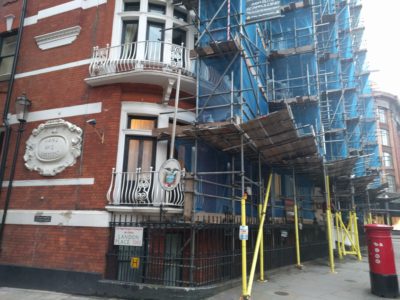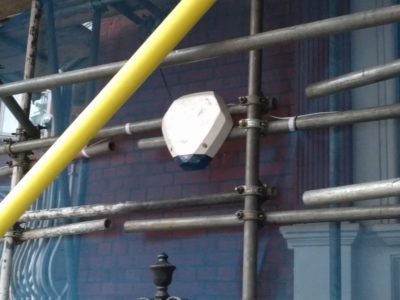Break-in Attempted at Assange’s Residence in Ecuador Embassy
Break-in
Attempted at Embassy; Fears Raised of Abduction
By
Joe Lauria
Special to Consortium News
Special to Consortium News
3
November, 2018
An attempted break-in at Julian Assange’s residence inside the Ecuadorian Embassy in London on Oct. 29, and the absence of a security detail, have increased fears about the safety of the WikiLeak’s publisher.
Lawyers
for Assange have confirmed to
activist and journalist Suzie Dawson that Assange was awoken in the
early morning hours by the break-in attempt. They confirmed to
Dawson that the attempt was to enter a front window of the embassy.
A booby-trap Assange had set up woke him, the lawyers said.
Scaffolding has appeared against the embassy building in the Knightsbridge section in London which “obscures the embassy’s security cameras,” the lawyers said.
Scaffolding has appeared against the embassy building in the Knightsbridge section in London which “obscures the embassy’s security cameras,” the lawyers said.
Scaffolding
near balcony where Assange has appeared.(Sean
O’Brien)
On
the scaffolding electronic devices, presumably to conduct
surveillance, can be seen, just feet from the embassy windows.
Later
on the day of the break-in, Sean O’Brien, a lecturer at Yale
University Law School and a cyber-security expert, was able to
enter the embassy through the front door, which was left open.
Inside he found no security present. Someone from the embassy
emerged to tell him to send an email to set up an appointment with
Assange. After emailing the embassy, personnel inside refused to
check whether it had been received or not.
One
of the apparent surveillance devices. (Sean
O’Brien.)
O’Brien
then noticed more scaffolding being erected and observed the
devices, which he photographed. Though a cyber-security expert,
O’Brien said he could not identify what the devices are.
“I’ve
never seen devices quite like this, and I take photos of
surveillance equipment often,” O’Brien said.
“There were curious plastic tubes with yellow-orange caps,
zip-tied to the front. I have no idea what these are but they
seem to have equipment inside them.”
The devices are pointed towards the embassy, where all the blinds were open, and not the street, he said. “The surveillance devices in the photos reveals no manufacturer branding, serial numbers or visible device information,” Dawson said. “The combination of the obscuring of the street-facing surveillance cameras and the installation of surveillance equipment pointed into instead of away from the Embassy, is alarming.”
The devices are pointed towards the embassy, where all the blinds were open, and not the street, he said. “The surveillance devices in the photos reveals no manufacturer branding, serial numbers or visible device information,” Dawson said. “The combination of the obscuring of the street-facing surveillance cameras and the installation of surveillance equipment pointed into instead of away from the Embassy, is alarming.”
Another
device. (Sean
O’Brien)
The
Ecuadorean government had to have given permission for the devices
to be installed as they are flush up against the embassy walls on
government sovereign territory, Dawson said.
O’Brien
said that previous visitors had described to him “closed and
locked doors. Security guards manning the desk at all times.
Privacy drapes, dark rooms with shuttered blinds. For such a
reversal of position to have occurred, there is only one
conclusion: the Ecuadorian Embassy is open for business. Wide
open.”
In May the Ecuadorian government of President Lenin Moreno shut off Assange’s electronic communications and denied him all visitors except his mother and his lawyers. Last month the government offered Assange a deal: his access to the world could be restored if he agreed not to comment on politics. Assange reportedly refused.
On
Thursday the government suddenly barred all access to Assange
visitors, including his legal team until next Monday, raising fears
that no witnesses could be present should there be an attempt to
abduct Assange over the weekend.
The
break-in attempt occurred on the morning that Assange was due
to testify via video-link to a court in Quito regarding Assange’s
conditions of asylum. Technical problems interrupted Assange’s
testimony. The
court ruled
against his
lawyer’s petition for protections for Assange.
The new Ecuadorian government indicated in the Spring that Assange would eventually have to leave the embassy. Assange fears that if he leaves the British government will arrest him on a minor charge of skipping bail when he legally sought asylum inside the embassy in June of 2012.
Assange and his lawyers fear that if he is detained by British authorities he would be extradited to the United States where they believe there is a sealed indictment against him possibly on espionage charges for simply publishing classified documents that he has not been accused of stealing.
Joe Lauria is editor-in-chief of Consortium News and a former correspondent for The Wall Street Journal, Boston Globe, Sunday Times of London and numerous other newspapers. He can be reached at joelauria@consortiumnews.com and followed on Twitter @unjoe .
The new Ecuadorian government indicated in the Spring that Assange would eventually have to leave the embassy. Assange fears that if he leaves the British government will arrest him on a minor charge of skipping bail when he legally sought asylum inside the embassy in June of 2012.
Assange and his lawyers fear that if he is detained by British authorities he would be extradited to the United States where they believe there is a sealed indictment against him possibly on espionage charges for simply publishing classified documents that he has not been accused of stealing.
Joe Lauria is editor-in-chief of Consortium News and a former correspondent for The Wall Street Journal, Boston Globe, Sunday Times of London and numerous other newspapers. He can be reached at joelauria@consortiumnews.com and followed on Twitter @unjoe .




No comments:
Post a Comment
Note: only a member of this blog may post a comment.